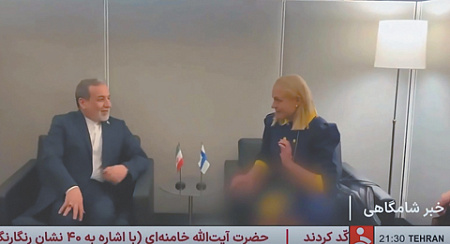
A recent incident involving Iranian state television’s broadcast of diplomatic meetings has ignited a potent debate across Europe and highlighted stark cultural differences on the global stage. During the sidelines of the United Nations General Assembly in New York, Iranian viewers were presented with a censored version of negotiations between Finland’s Foreign Minister, Elina Valtonen, and her Iranian counterpart, Abbas Araghchi. The perceived ‘bare legs’ of Minister Valtonen, deemed subversive to the conservative tenets of the Islamic Republic, were conspicuously blurred out, a move that quickly drew international attention.
This act of censorship was not an isolated event. Similar digital alterations were applied to footage of Minister Araghchi’s meeting with Sweden’s Foreign Minister, Maria Malmer Stenergard. Both European ministers were reportedly wearing dresses that did not extend to their ankles, a common and accepted attire in Western diplomatic circles but evidently clashing with the strict sartorial expectations enforced within Iranian media. The clear intent behind these edits was to align the appearance of the foreign dignitaries with prevailing moral codes, potentially avoiding internal criticism within Iran.
However, once these edited broadcasts reached Finland and Sweden, they triggered a robust public outcry and a lively national discussion. Social media platforms in both Nordic nations were inundated with messages of support for their respective foreign ministers, often accompanied by sharp condemnation of the Iranian state’s censorship practices. Many users underscored the importance of cultural autonomy and the right of diplomats to represent their countries without being subjected to external dress codes.
Minister Valtonen herself addressed the controversy, firmly stating her principled stance. In an interview with Finnish media, she emphasized, “I don’t change my clothes depending on who I meet. For example, I have a rule: I will not attend events where they demand covering the face or hair.” She further characterized the incident as a “sad example of human rights violations” perpetuated by Iranian authorities, implicitly linking the media censorship to broader concerns about women’s rights and personal freedoms within Iran.
While the diplomatic incident has undeniably created a stir and drawn international scrutiny, initial assessments suggest it is unlikely to fundamentally alter the established bilateral relations between Finland, Sweden, and Iran. Nevertheless, the episode serves as a powerful reminder of the intricate interplay between cultural norms, media control, and diplomatic exchanges in an increasingly interconnected yet ideologically diverse world, particularly concerning the representation and autonomy of women in public life.
